Napoli and Milan met in Serie A this weekend with both sides looking to keep their Europa League places secure. This tactical analysis will look at the tactics both teams used in their attempt to pick up the three points and continue the good form that both teams have shown since the resumption. It was Atalanta that all but ended Napoli’s hopes of Champions League football next season with a 2-0 win over the Partenopei in last week, however, Milan are one of the form teams in Serie A right now after wins over Lazio and Juventus over the last week with some fluid attacking football and the return of Zlatan Ibrahimović netting them seven goals against the top two. Meanwhile, Reno Gattuso’s men nine-match unbeaten run across all competitions came to an end at Atalanta but, during which they won the Coppa Italia, creating a safety net for Napoli with a guaranteed Europa League spot. Gattuso’s men rebounded well with good wins over Roma and Genoa in their last two matches as the fixtures continue to come thick and fast.
Game context
In their last encounter in Serie A back in November 2019, these two sides played out a tight game in Milan resulting in a 1-1 draw. Napoli switched into their 4-4-2 shape, which is a regular twist that day while Milan set up in a 4-3-3/4-5-1 shape with Giacomo Bonaventura’s excellent strike from outside the box cancelling out Hirving Lozano’s earlier header. With only two points separating the two sides and Napoli already guaranteed European football next season, this game is a significant match-up for Milan to continue their push for a Europa League place.
Lineups

For Gattuso and Napoli, it is more of the same with the team he selected in their 4-3-3 shape for this game. The player rotations are almost robotic in the tight turnaround of games and this game was no different. It shows the togetherness of the squad and the man-management of Gattuso with his players that the is no significant drop-off in performance regardless of which players start each game recently. Mario Rui continued at leftback while Giovanni Di Lorenzo and Kalidou Koulibaly came back into the back four after sitting out against Genoa. Fabian Ruiz and Stanislav Labotka continued in midfield but were partnered by Piotr Zielinski for this game. Dries Mertens lead the line alongside the ever-present Lorenzo Insigne with Jose Callejon coming back into the side.
For Milan, Ibrahimović continued as the focal point in the top line in their 4-2-3-1 as he did against Juventus. Hakan Çalhanoğlu came back into the side underneath him as the only change from the side that beat Juventus last time out.
Tactical Overview
For Napoli, it is a continuation of a philosophy and tactics that underpins everything that they do. Build from the back to create overloads across the pitch by using minimal numbers to pin in the opponent backline. This tactical analysis will look at how Gattuso continues to add little subtle differences into his preparation for different sides to add new tools to his normal quick passing style to unlock the Milan backline and create moments of danger in front of Gigi Donnarumma’s goal.
This analysis will also look at the defensive shape of Milan in the first half that allowed Napoli to build dominance in the game and how Stefano Pioli’s tactical changes allowed Milan the platform to drag themselves back into the game.
Napoli getting their wide players marked
It is not new information that Napoli want to progress their fullback’s up the pitch. How the opponent deals with this threat is always dictated by Gattuso rather than the opposition coach. This allows Napoli to dominate the game for one of a couple of reasons. Sit off in a deeper position and you allow Napoli dominance in front of the block while if you press high and mark man to man rather than zonally then they will use well-practised rotations of position to allow themselves to attack certain spaces and channels and this game was no different early.
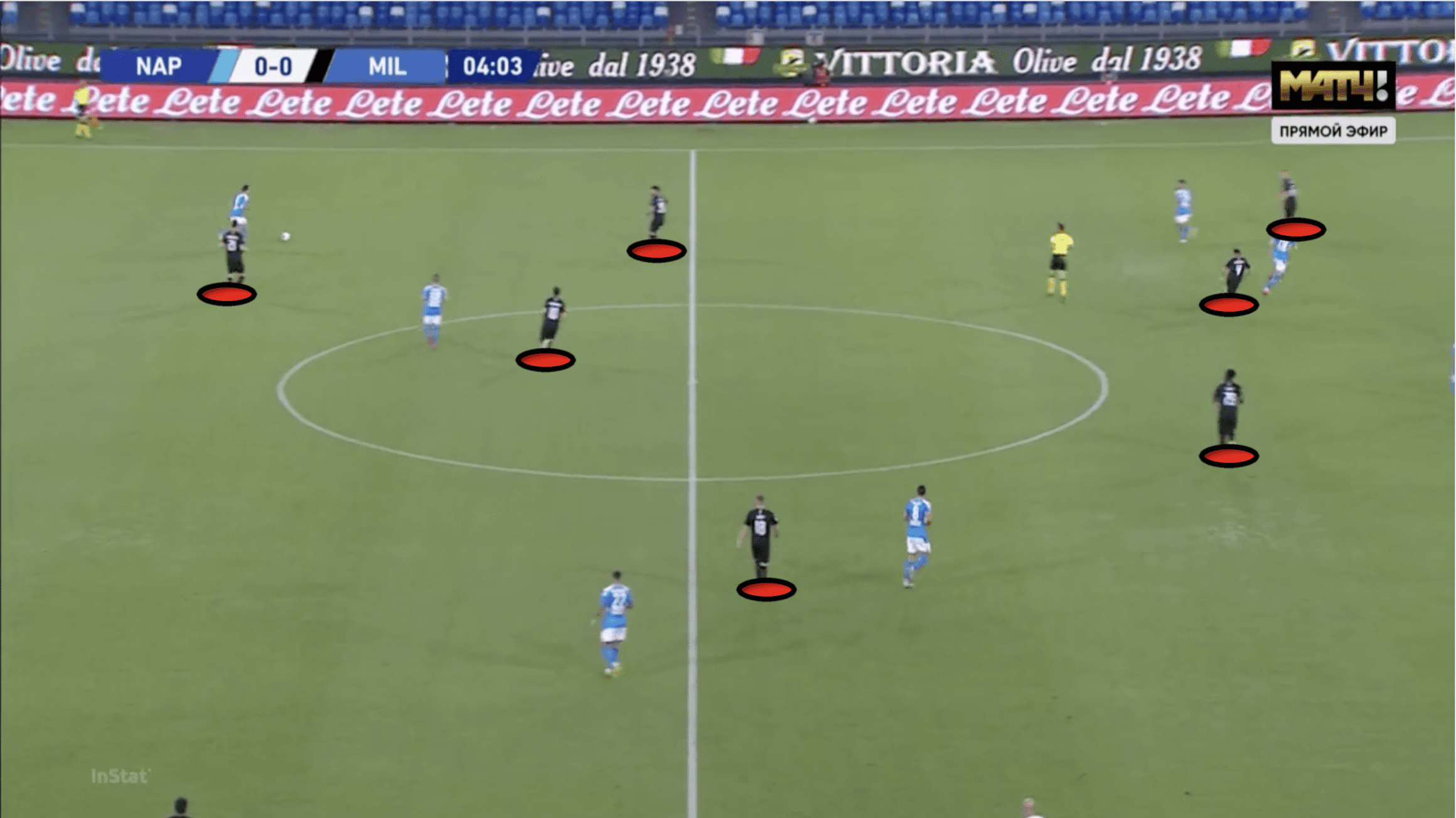
Here we see an early image of the game. The first thing to make clear is Milan’s defensive shape. Ibrahimović clearly leading the line as the lone front player. His job during the game was to direct play and stop Napoli switching between centrebacks. It also left him on the ball side a lot of times and allowed Milan to counter towards him when possible. Napoli’s attempt to dictate which defenders dealt with the ball is on show here and Mario Rui is being pressured by the wide midfield player with the two central midfielders and the back four staying connected to each other. For Milan, at times this meant that they defended in a 4-5-1 shape and this made it difficult to get possession of the ball higher up the pitch at times. In Napoli’s plan, this meant that the wide player had to get marked by the fullback in order to attract pressure. As soon as this was the case, in this scenario, Insigne draws the fullback out of position to receive the ball to feet, however, the space is now beyond the line and Napoli take advantage of this.
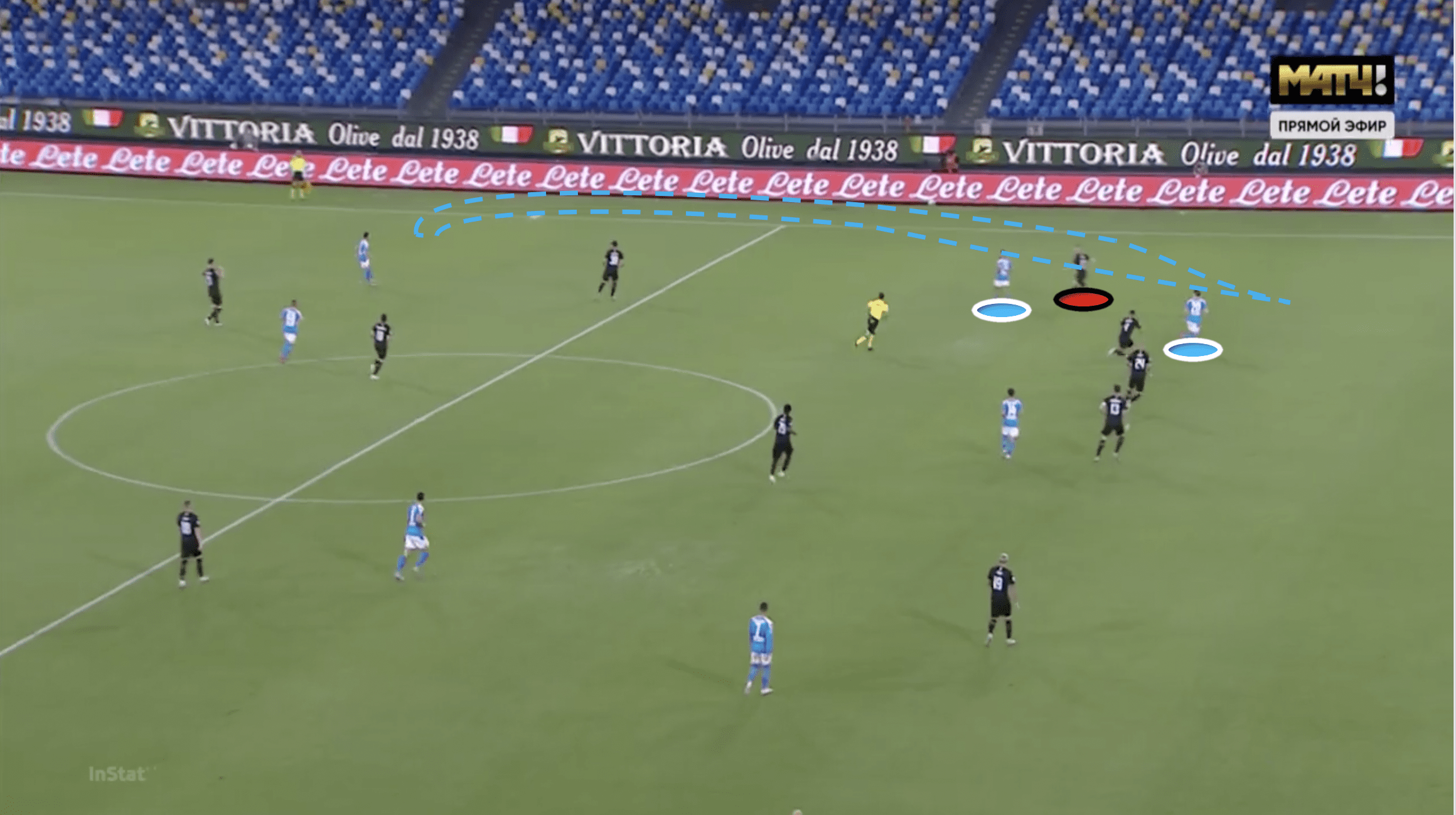
Here we see the same situation from later in the first half in an almost identical moment. The Napoli wide player gets marked by the Milan fullback and shows towards the ball with the fullback in possession. This opens up the space beyond the Milan line and allows Rui to play in behind the tracking defender for a midfield runner to receive. It is similar to the tactics used by Gattuso in the Roma game and allows Napoli several different options from this type of moments. For example – First, they can attack quickly and threaten the Milan goal. Second, they can use this moment to move up the pitch together and keep possession deep in Milan’s half – Thus nullifying any counter-attack as Milan drop deeper together to protect their goal.
Once this scenario has been played out, an adjustment in the decision making of the backline from Milan allows Napoli to use another tried and tested tactical mainstay of their attack to create more issues. With the wide players now moving inside to be marked by someone else but only after the Napoli fullback has progressed high enough up the pitch to create some genuine attacking width in the space vacated.
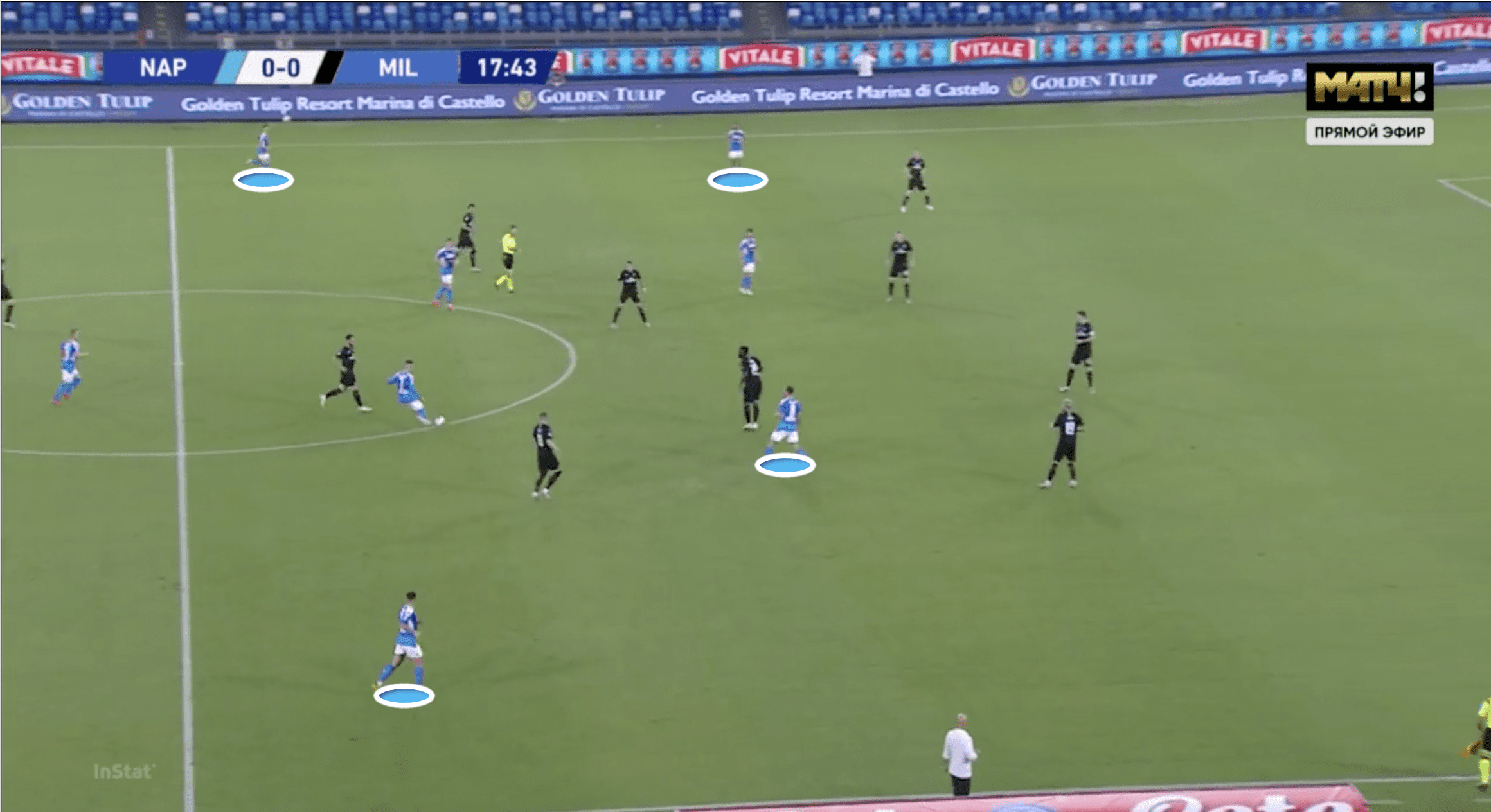
Here we see those two different pictures playing out at the same time for Napoli. With Fabian Ruiz about to switch play, we can see on the ball side the wide player inside and between lines as he looks to receive. He is marked by the deepest Milan midfield player and therefore this creates room for Di Lorenzo as he advances up the pitch to support the attack. Meanwhile, on the far side, a potential 2v1 situation is about to unfold with the switch of play. Insigne supported in the furthest zone by Rui can take advantage of the narrowness of Milan by doubling up against the fullback quickly when the ball arrives. Either this or they use it is a method to drag the opponent to the one side again so they can attack on the other side where the opponent becomes weakest again.
In this very attack, Napoli switched quickly through the midfield and with several excellent rotations they manufactured a chance with Fabian Ruiz that he really should score from.
This type of shape and structure from Napoli is difficult to deal with as it is so fluid and unpredictable in its movements. Sooner or later they will break you down it is the final product that tends to be lacking at times. If like Milan you do your best to defend the man rather than the zone through midfield, it can be a tireless task to track and cover constantly without the ball and while it is the bolder of the defensive options it can leave you with little energy for attacking if you spend long spells without the ball like Milan did in this match.
It is no surprise that Napoli have the highest possession stats since the resumption and when they turn this weight of possession into genuine conversion of chances, their opponents need to be careful it’s not them on the receiving end!
Milan’s Possession battle
In moments of good possession, which in all fairness were few and far between in the first half for Pioli’s side, Milan found life tough to break down a well organised and disciplined defensive unit that works well for each other across the pitch.
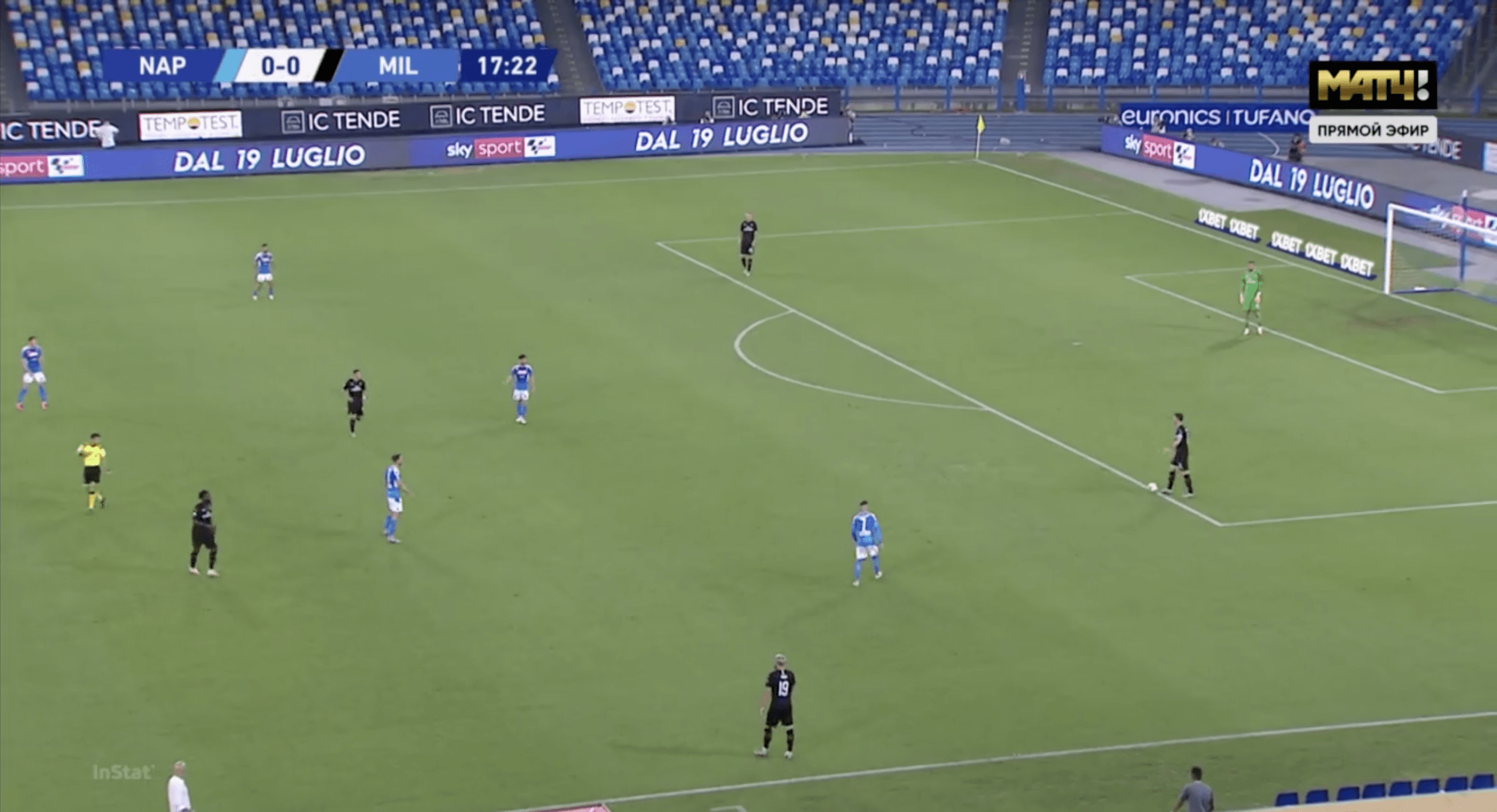
Here you can see Napoli being proactive and setting up to press high up the pitch and keep Milan in their own half unless they want to play longer in the target of Ibrahimović. It operates in more of the 4-3-3 in this moment with the two higher midfield players pushing through to support the front three by blocking passing lanes into midfield. It takes a bold team to play through in these moments and therefore the recovery of the long ball becomes the priority of both sides. Napoli defended in a 4-1-4-1 shape in a medium block more frequently and this brought some interesting structural changes which were to allow their wide players to deal directly with the Milan fullbacks and also protect balls directly into the feet of Ibrahimović either through a deterrent or a potential pressing moment from a ball played into that central pocket.
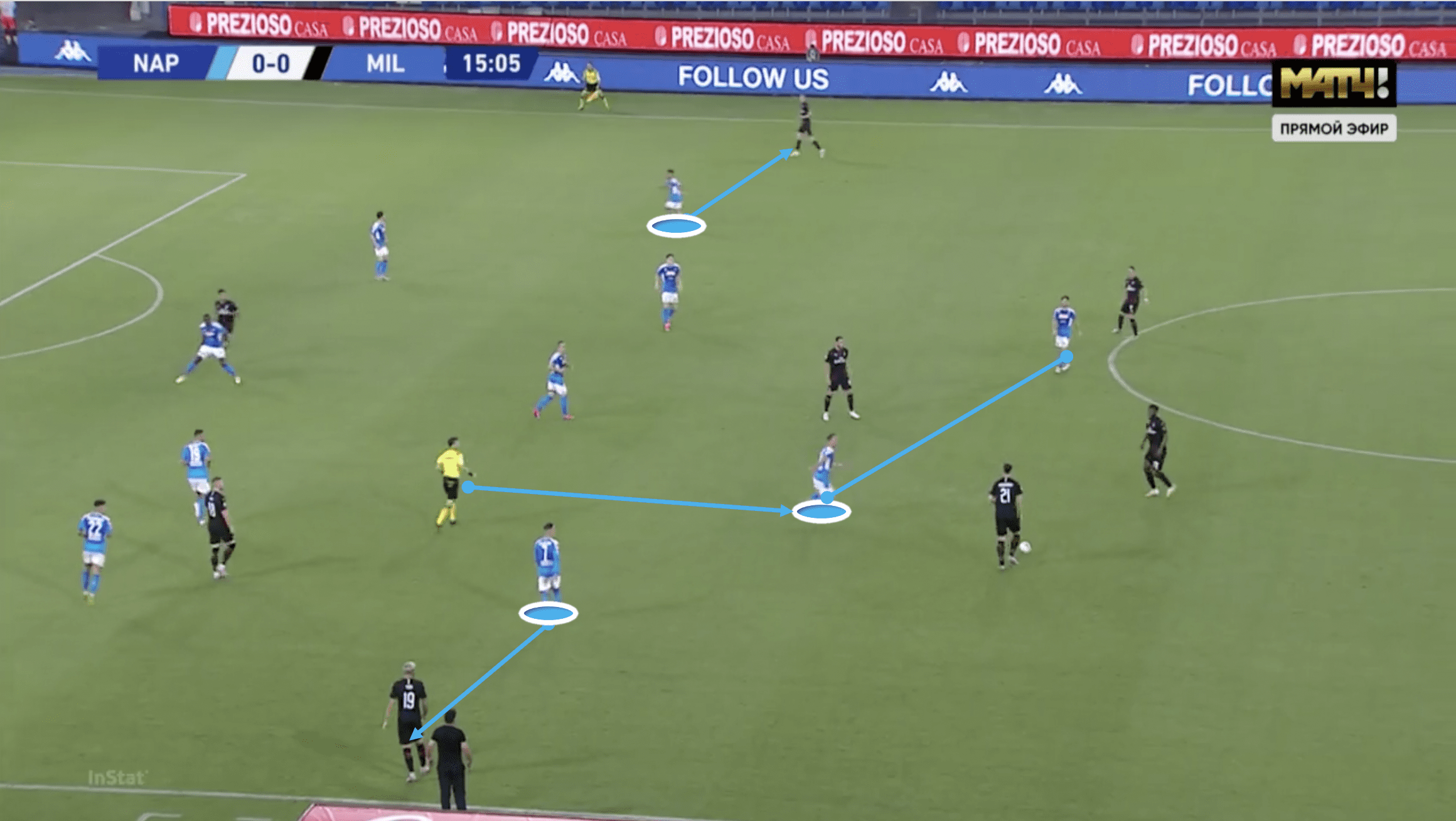
Here, you can see the picture clearly. The wide players deal directly with the advancing Milan fullbacks to keep the compact shape together while the advanced central midfield player on the ball side steps up alongside Mertens to create a front two and protect passing lanes into the top line. The non-ball side advanced midfielder drops in alongside the supporting Labotka to maintain a midfield four at all times and so keeping the compact shaped together. Once the ball is played backwards by Milan it is a trigger to press the ball together to recover the ball on the negative or force the ball all the way back to the goalkeeper where the image from earlier comes back into play again.
Trading blows through the game
When Milan were able to find a way through it was by playing through this block and quickly out again to a fullback in an advanced position. This was the cause of Napoli conceding through a Hernandez volley at the back post.
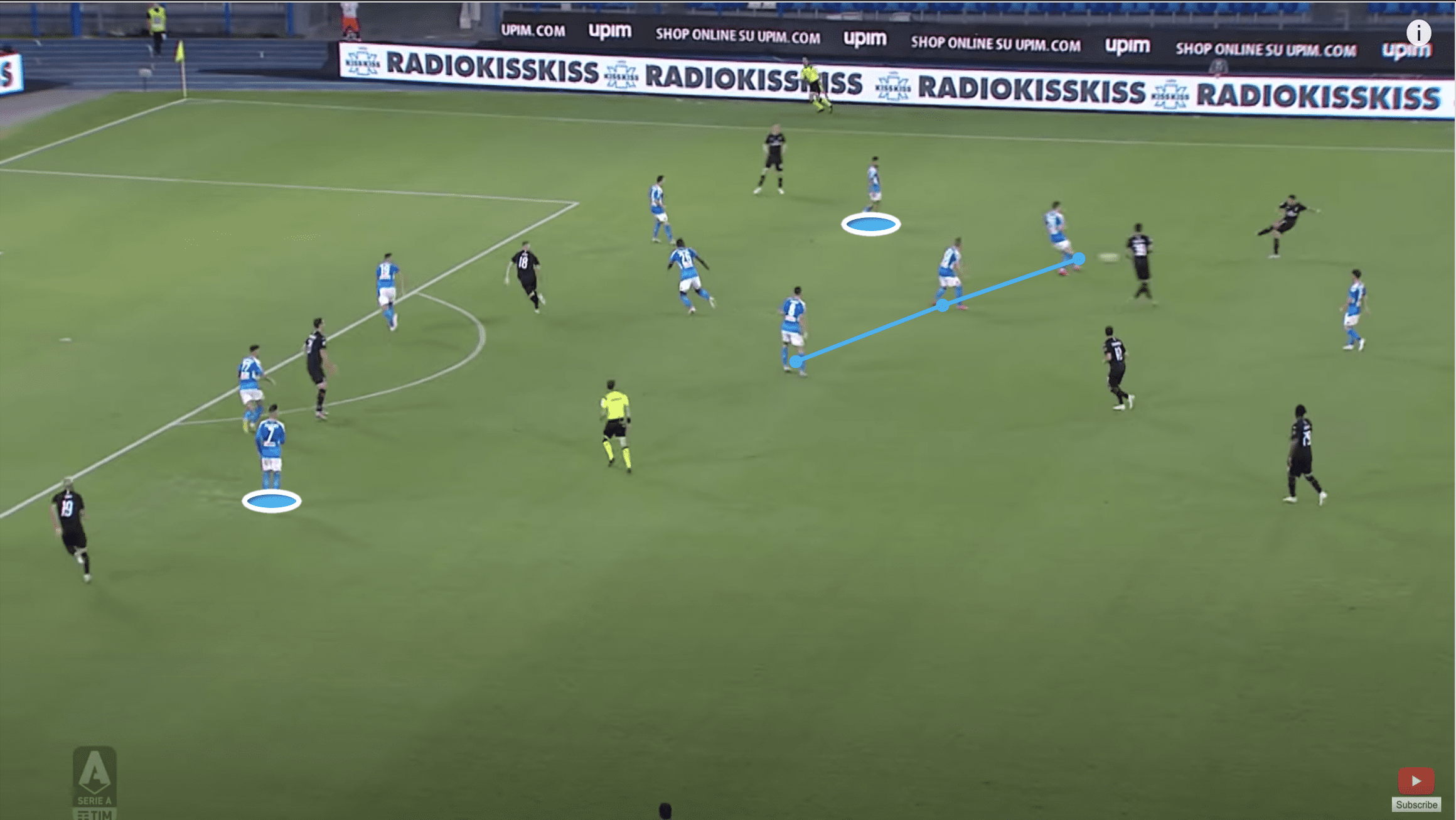
Here we can see the pass from deeper to find the run of Rebic as a result of poor positioning from Koulibaly, a rare error from the centreback. With the wide player Insigne deeper, dealing with the advancing fullback Conti the midfield three fail to stop the passing lane into the channel for Rebic’s run. When you have wide forwards play such a big part in the defensive organisation of your team, no matter how hard they work they will make errors. Here the culprit is Callejon.
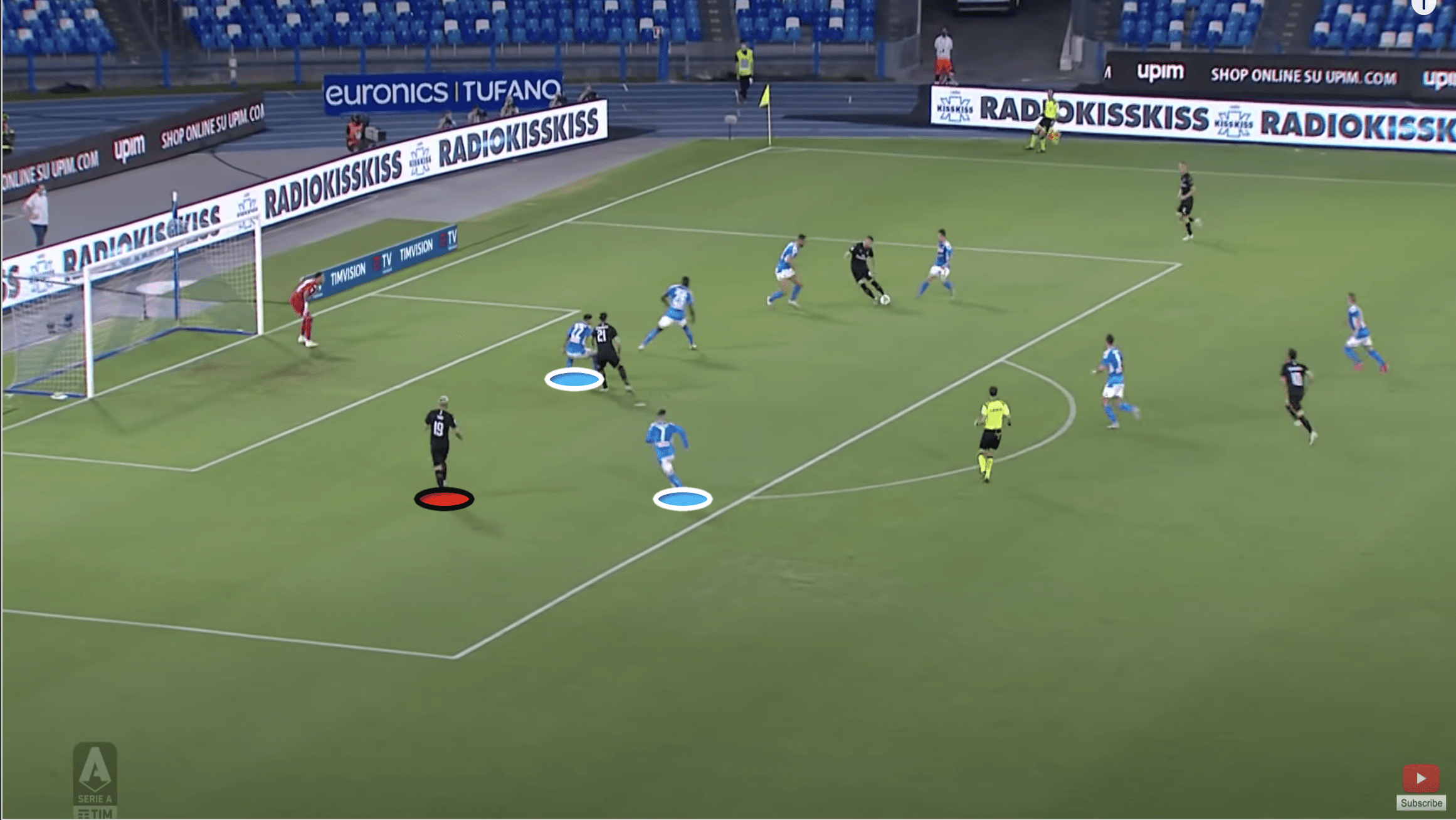
As Rebic cuts back, the back four are wrongfooted but still in good shape. Or at least they would be if Callejon follows Hernandez as he should. He doesn’t and because of the narrowness of the backline and Ibrahimović’s desire to pull onto the Napoli fullbacks where possible, Hernandez’s late run and finish gave him an unopposed finish at the back post. It was a well-worked goal and completely against the run of play at this point.
Two of the next three goals are set pieces. Di Lorenzo’s close-range finish from an Insigne free-kick evened the scores up and despite the type of goal was deserved by Napoli in the context of the game.
Napoli went in front fifteen minutes into the second half through a Dries Mertens finish from a cutback after good play from Callejon down the right-hand side.
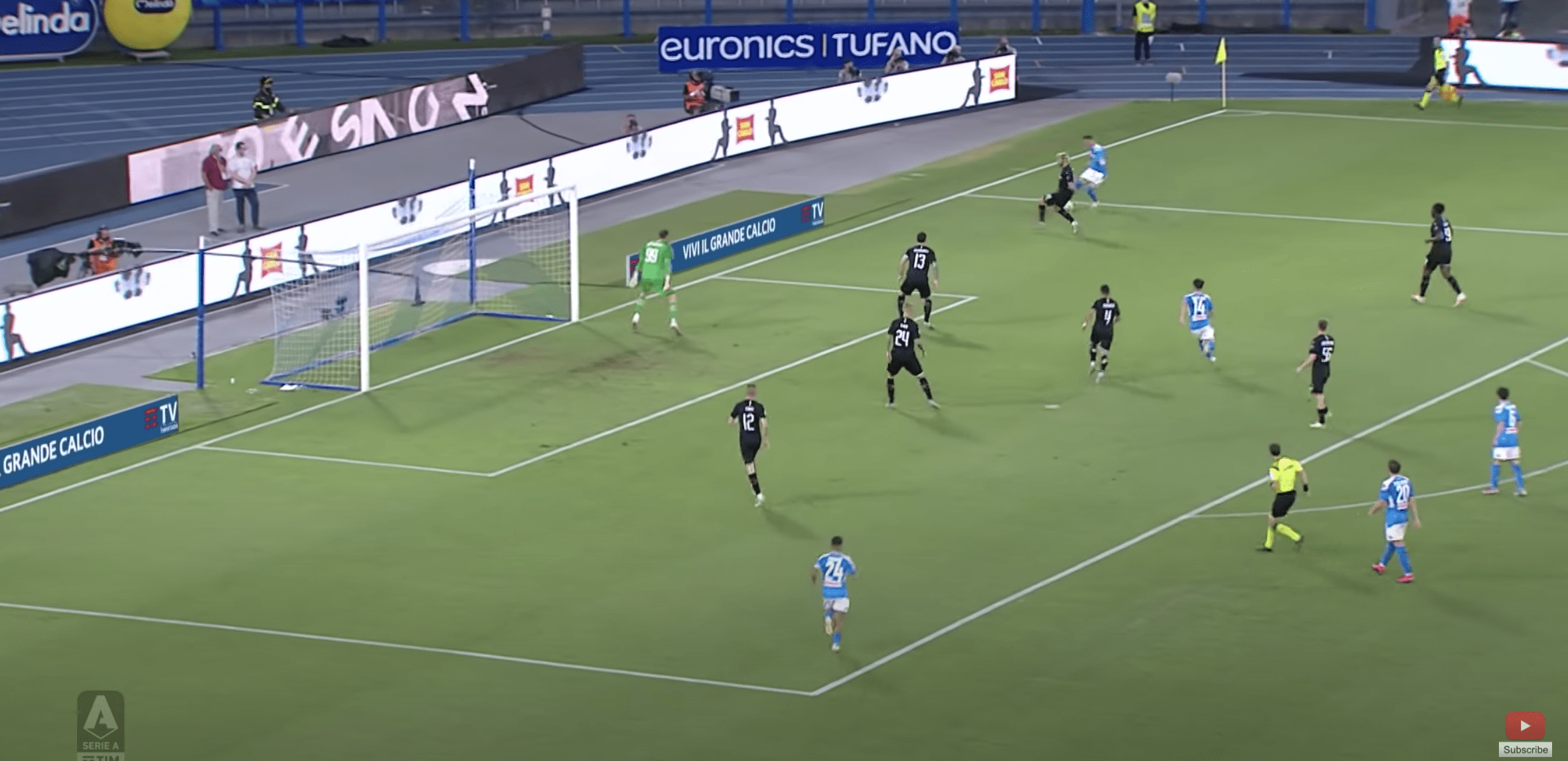
It’s difficult to justify how this image is the overview of Mertens’ goal. Milan’s position to defend the goal here is sound based on the ball, the goal and the opponent. That’s where the good work ends though. Mertens sneaks in front of Ismaël Bennacer and scuffs his shot towards goal where Donnarumma should do better to stop the shot than he does.
At this point, there should be one winner in this game however, Pioli’s subtle changes at half time were causing Napoli some issues that resulted in the equalizer from the penalty spot.
His change to 4-1-3-2 and the introduction of Alexis Saelemaekers allowed them to apply more pressure up the pitch and create moments of success throughout the second half.
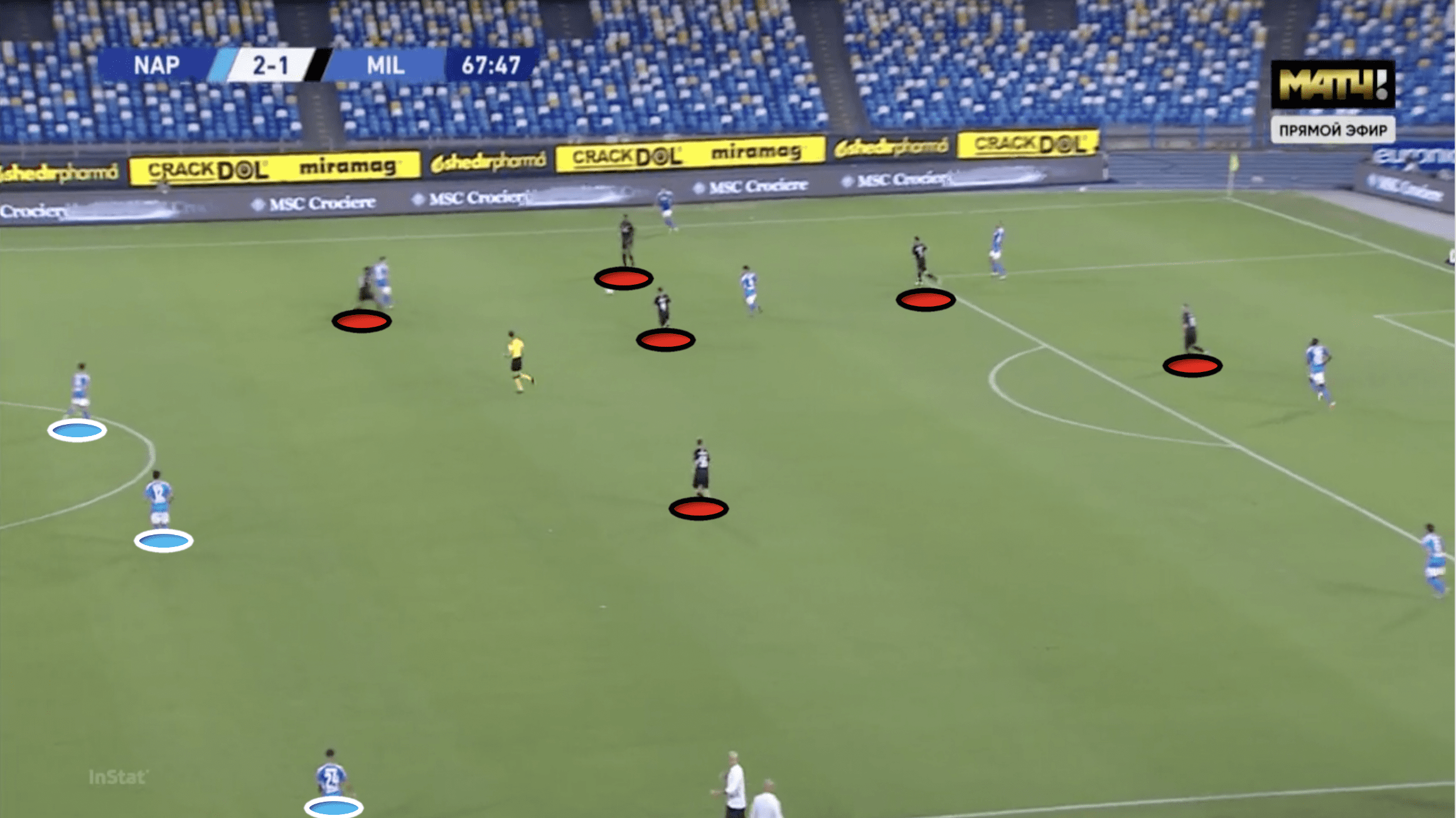
Here you can see the change of intent from Milan during the second half. The risk versus reward of the tactical change can be seen clearly here. Napoli are used to these types of moments and are happy to try and play through into the free players in the mid-third of the pitch. However, if Milan are successful as they were on several occasions then a fast break is a clear danger for Napoli. It created a much more equal second half and at times pushed Napoli back deep in their own half. This was especially so after the withdrawal of Ibrahimović who Pioli replaced with Rafael Leao. A more mobile and willing front two allowed for a more dynamic unit pressing structure and slowly Milan turned the tide as Napoli’s high energy players began to tire.
Conclusion
This was a game that ebbed and flowed back and forth and was one to add to the list of those games that ultimately got away from Napoli. Lots of attractive possession that only yielded a tap in from a set-piece and a scuffed finish that the goalkeeper should save. It is a familiar story in some recent games that have relied on individual brilliance to make the difference. That doesn’t mean they got lucky to steal a point in this one, but eighteen shots with ten on target should be a marker for better things. They shaded possession in this one and were successful again attacking down the left-hand side through Rui and Insigne being influential. With the Europa League secure you can sense that Gattuso is rotating and using his time to add little things into his teams’ toolbox to make them a little more flexible to break teams down. This is especially true with his use of the wide players and the connection with the fullbacks. Milan are unbeaten since the restart, six games for four wins and now two draws and are hot on the heels of those above them. Ibrahimović’s return and Rebic’s goalscoring record have been big factors but it was Pioli’s flexibility and the impact of those off the bench that got them a point in this one.
Next up Milan entertain Parma and Napoli travel to Bologna in two matches against mid-table teams with little to play for. Expect Pioli to rotate after three big matchdays and Gattuso to tinker once again with his side. Given the current form, Milan would expect to pick up the points and Napoli will also be confident but in this run-in with teams literally bouncing from one game to the next anything is possible.





Comments